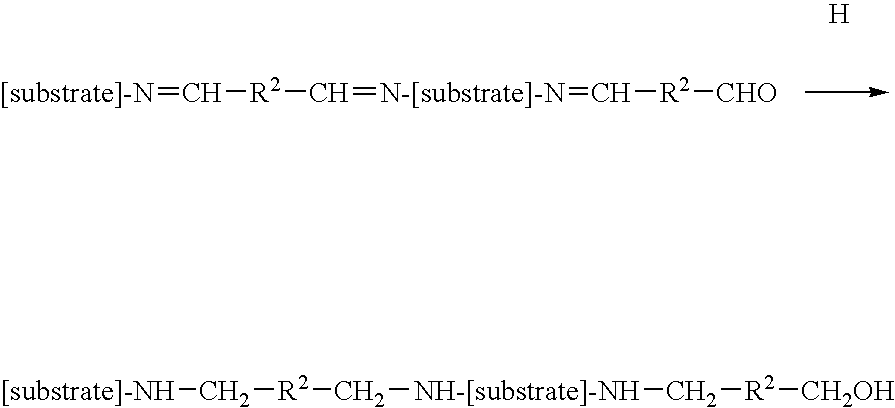Treatment of implantable medical devices resistant to calcification
- Summary
- Abstract
- Description
- Claims
- Application Information
AI Technical Summary
Benefits of technology
Problems solved by technology
Method used
Image
Examples
example 1
Treatment of Substrate According to Steps (A) (B) and (C) of the Method of the Invention
[0096]Treatment with Glutaraldehyde Solution (S1)
[0097]The substrate was treated with solution (S1) for at least one month at ambient temperature (approximately 25° C.).
[0098]At the end of said treatment, the treated substrate was cut into squares measuring 8 mm, approximately 7 mm, on each side.
[0099]The samples resulting from the substrate thus treated were rinsed three times with ultra pure water.
[0100]Treatment with Sodium Cyanoborohydride Solution (S3)
[0101]Said rinsed samples were transferred to a 150 ml bottle with a rectangular cross-section containing approximately 100 ml of solution (S3). The reaction medium was then stirred at approximately 50 rpm−1 at ambient temperature (approximately 25° C.) for approximately 24 hours.
[0102]The samples thus treated were rinsed three times with ultra pure water.
[0103]Treatment with Chloromethylsilane Solution (S4)
[0104]The samples thus rinsed were tr...
example 2
Treatment of the Substrate According to Steps (A), (A1), (B) and (C) of the Method of the Invention
[0106]Treatment with Glutaraldehyde Solution (S1)
[0107]The substrate was treated with solution (S1) for at least one month at ambient temperature (approximately 25° C.).
[0108]At the end of said treatment, the treated substrate was cut into squares measuring approximately 7 mm on each side.
[0109]The samples resulting from the substrate thus treated were rinsed three times with ultra pure water.
[0110]Treatment with poly(propylene glycol)bis(2-aminopropyl ether) (Jeffamines) Solution (S2)
[0111]The samples thus rinsed were transferred to a 150 ml bottle with a rectangular cross-section containing 100 ml of solution (S2). The bottle was stirred at approximately 50 rpm−1 for approximately 1 hour at ambient temperature (approximately 25° C.).
[0112]Approximately 5.76 g of morpholinoethanesulfonic acid (MES) were added to the reaction medium. The reaction medium was stirred at approximately 50 ...
example 3
Treatment of the Substrate According to Steps (A) (A1), (B) and (C) of the Method of the Invention
[0121]The same procedure was repeated except that in the last step (C) the trimethylsilylimidazole solution (S5) was used instead of the chloromethylsilane solution (S4).
PUM
 Login to View More
Login to View More Abstract
Description
Claims
Application Information
 Login to View More
Login to View More - R&D
- Intellectual Property
- Life Sciences
- Materials
- Tech Scout
- Unparalleled Data Quality
- Higher Quality Content
- 60% Fewer Hallucinations
Browse by: Latest US Patents, China's latest patents, Technical Efficacy Thesaurus, Application Domain, Technology Topic, Popular Technical Reports.
© 2025 PatSnap. All rights reserved.Legal|Privacy policy|Modern Slavery Act Transparency Statement|Sitemap|About US| Contact US: help@patsnap.com


